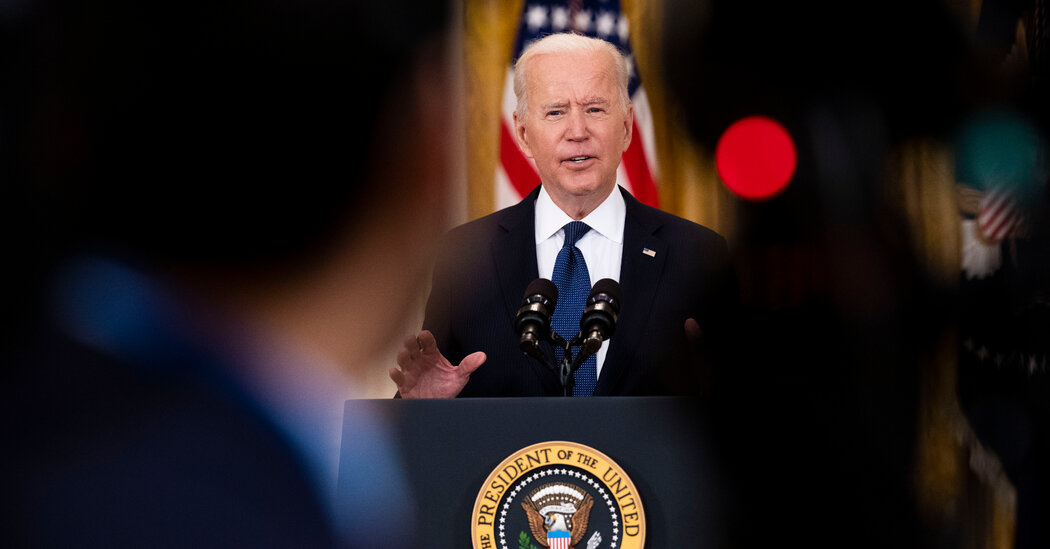ECONOMIC NEWS
Biden Defends Unemployment Benefits, Provided Workers Accept Job Offers
WASHINGTON — President Biden ordered the Labor Department on Monday to ensure that unemployed Americans cannot draw enhanced federal jobless benefits if they turn down a suitable job offer, even as he rejected claims by Republicans that his weekly unemployment bonus is undermining efforts to get millions of Americans back to work.Stung from a weekend of criticism over a disappointing April jobs report, Mr. Biden struck a defiant tone, seeking to make clear that he expects workers to return to jobs if they are available, while defending his signature economic policy effort thus far and blaming corporate America, in part, for not doing more to entice people to go back to work.The president told reporters at the White House that child care constraints, school closures and fears of contracting the coronavirus had hindered job creation last month, and he challenged companies to help workers gain access to vaccines and to raise their pay.“The last Congress, before I became president, gave businesses over $1.4 trillion in Covid relief,” Mr. Biden said. “Congress may have approved that money, but let’s be clear: The money came from the American people, and it went from the American people to American businesses, many of them big businesses, to help them get through this pandemic and keep their doors open.”He added, “My expectation is that, as our economy comes back, these companies will provide fair wages and safe work environments.” He said that if they did, “they’ll find plenty of workers, and we’re all going to come out of this together better than before.”Mr. Biden also promised more relief was working its way into the economy through measures created by the $1.9 trillion “American Rescue Plan” that the president signed into law in March. That includes help for child care providers and aid for state and local governments that Treasury Department officials began to make available on Monday.His defense of the stimulus funds and his administration’s handling of the economy comes as Mr. Biden is trying to win support for even more federal spending, including a $2.3 trillion jobs proposal centered on physical infrastructure.Republicans have already criticized Mr. Biden for the disappointing jobs numbers and have suggested he is wreaking havoc with the economic recovery. In particular, they blamed a provision in his rescue plan that extended a $300-per-week federal supplement for unemployed Americans. They say those benefits are depressing hiring by discouraging Americans from returning to work.An aide to Senator Mitch McConnell of Kentucky, the Republican leader, emailed reporters on Monday, accusing Mr. Biden of placing “handcuffs” on the recovery by extending the jobless benefits.Senator Ben Sasse, Republican of Nebraska, said on Monday that Mr. Biden was “all over the place” on the issue.“He wants to go after folks who are gaming the system, but he’s denying the reality that his policies are making the situation worse, so he’s trying to make struggling businesses the boogeymen,” Mr. Sasse said in a news release. “Here’s the deal: Bad federal policy is making unemployment pay more than work, and millions of jobs aren’t getting filled.”Mr. Biden said on Monday that his administration would make clear that any worker who turned down a suitable job offer, with rare exceptions for health fears related to the virus, would lose access to unemployment benefits.To ensure those rules are being followed, the Labor Department will work with states to reinstate work search requirements. Those rules, which require that anyone collecting unemployment benefits provide proof that they are actively searching for work, were suspended during the pandemic.Twenty-nine states have already reinstated them, and the Labor Department will “work with the remaining states, as health and safety conditions allow, to put in place appropriate work search requirements as the economy continues to rebound, vaccinations increase, and the pandemic is brought under control,” White House officials said in a fact sheet.The president also pointed to new guidance issued Monday by the Treasury Department that will help state, local and tribal governments gain access to more than $350 billion in relief funds made available by the American Rescue Plan. He said that money would help speed hiring and economic growth.The details of how the Treasury Department will disburse those funds, which can be spent on pandemic-related costs, have been eagerly awaited by states, cities, territories and tribal governments that are expected to receive money. But several Republican-led states and the Biden administration are in a legal confrontation over whether states can cut taxes after taking relief money and using it to solidify their budgets.A fact sheet accompanying the announcement about the distribution on Monday made clear that the relief money could not be used to subsidize tax cuts directly or indirectly, which could discourage some states from accepting funds.“The American Rescue Plan ensures that funds needed to provide vital services and support public employees, small businesses and families struggling to make it through the pandemic are not used to fund reductions in net tax revenue,” the Treasury Department said. “If the funds provided have been used to offset tax cuts, the amount used for this purpose must be paid back to the Treasury.”The Treasury Department also issued detailed guidance to states explaining how it would determine if the money was being used properly and in which cases the relief funds could be recouped. If a state does cut taxes, it will have to demonstrate to the Treasury Department that it offset that lost revenue with spending cuts or another source of revenue that does not include the fiscal recovery funds. If the state cannot do that, the department can claw back that amount of money.“This process ensures fiscal recovery funds are used in a manner consistent with the statute’s defined eligible uses and the offset provision’s limitation on these eligible uses, while avoiding undue interference with state and territory decisions regarding tax and spending policies,” the guidance said.Treasury and White House officials made clear that they would scrutinize how the funds were being used to ensure that state budgets were not being gamed to violate the intent of the law. A new recovery office at the Treasury Department will coordinate with states to help determine if their policies are in line with conditions set forth in the law.The relief money also cannot be paid into state pension funds to reduce unfunded liabilities.A White House official would not comment on whether initiatives like Montana’s return-to-work bonuses could be funded using relief money. States and cities are being given broad discretion on how they can use the money, which is intended to replace public sector revenue that was lost during the pandemic; to provide extra pay for essential workers; and to be invested in sewer, water and broadband infrastructure.The Treasury Department’s directive is unlikely to put the legal fight over whether states can cut taxes to rest. Mark Brnovich, the attorney general of Arizona, which is suing the Biden administration, said that Treasury Secretary Janet L. Yellen’s guidance failed to clarify the matter.“Arizona should not be put in a position of losing billions of dollars because the federal government wants to commandeer states’ tax policies,” Mr. Brnovich said.The allocation of the funds is also likely to be a contentious matter as the money starts to flow. Some states have complained that states that managed the pandemic well are essentially being penalized because the formula for awarding aid is based on state unemployment rates.The Treasury Department said on Monday that the states that were hardest hit economically by the pandemic would also get their money faster.Local governments will generally receive half of the money this month and the rest next year. But states that currently have a net increase in unemployment of more than two percentage points since February 2020 will get the funds in a lump sum right away.Officials also said Monday that the administration would issue new guidelines meant to speed money from the recovery act to help child care centers reopen, and that the Labor Department would highlight a program that allows some unemployed workers to accept offers of part-time jobs without losing access to the federally supplemented benefits.Mr. Biden said that the efforts would help the economy recover — and that the rebound from recession remained on track.“Let’s be clear: Our economic plan is working,” he said. But he said recovery would not always prove to be easy or even. “Some months will exceed expectations,” he said, “others will fall short.”
Source link













